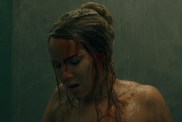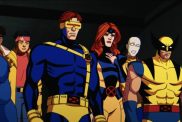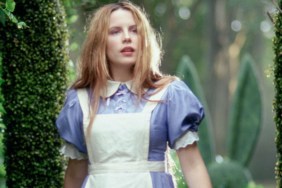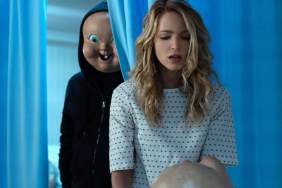One of the most unpredictable actors working today, Crispin Glover balances his time between acting in some very mainstream films as well as directing his own independent features. This week is momentous for him in both regards; Tim Burton’s Alice in Wonderland hits DVD today while all this week his self-directed films What Is It? and It is Fine! EVERYTHING IS FINE. screen at the IFC Center in New York City.
ComingSoon.net caught up with Crispin to discuss his work for Burton as Stayne, the Knave of Hearts, and how he juggles time between Hollywood and independent productions.
Q: Before this project, had you met Tim Burton before?
Crispin Glover: Yeah, I first met Tim Burton right after he had done “Pee Wee Herman’s Big Adventure.” It was a long, long time ago and we were friendly. We were a bit social and I had always liked him and knew he was an interesting artist and filmmaker and I was glad to know him. I hadn’t talked to him for many, many years. I tour with my own films that I make and I was in Australia touring. I perform a live show before them. In fact, I’m going to be in New York [this] week at the IFC Center showing both of the films and doing mixed performances beforehand Monday through Thursday. But I was in Australia doing the show and got an email from my agent saying there was interest in me for “Alice in Wonderland” and I thought it would maybe be a day or two for some character I didn’t know. I thought it sounded great and it didn’t interfere with my tour or anything. I could continue on into Europe after that. But then the offer came in that it was virtually for the run of the film and I was very happy. I still didn’t know what the character was and when I got the character name with the part I didn’t yet have the script. So I looked up the character, the Knave of Hearts in the original “Alice in Wonderland” and it didn’t seem like the character would require the run of the film. I figured they must have changed it in some way. Then, obviously, I did get the script and the character was very different than the book character and they had made it into a sequel of sorts. I was just ecstatic. And I’m still ecstatic just that I’m in it. It’s a great thing. I mean, it’s a real pleasure working on it.
Q: Can you talk a little about what it was like being on-set. Were you acting with the other actors or was it all green screen?
Glover: Oh yes. Everybody’s that in the scene was always there for the live actors as opposed to the actors that did voices for the characters. For the various actors that were going to be recorded, for their voice they had other actors playing those parts and you could possibly interact with their sight line of a tennis ball or possibly a cardboard cutout image of their character. But when you were interacting with any of the characters–like plenty of my scenes with the Queen of Hearts–Helena was there playing those scenes and, of course, Mia was playing Alice and Johnny was playing the Mad Hatter.
Q: You’ve played a lot of great roles in your career. Do you find that you’re very picky in choosing who you play?
Crispin: The way that I’ve chosen to do characters has changed over the years. There was a time in my career where I was extremely particular. Right after “Back to the Future” had come out, I felt like I had a certain obligation to find characters or films that somehow psychologically reflected what my own interests were. The first film I had acted in after “Back to the Future” came out was “River’s Edge.” It’s still a film that I’m very proud of and it’s a very good film and I’m glad I did that film. But then a lot of the films I acted in did not reflect what my psychological interests were and they did not necessarily make that much money and it was not that good for my acting career. I really stuck with that for about 15 years. When I started making my own films that I was financing myself, I shot the first film in what will be a trilogy called “What Is It?” I was still doing technical edits and finishing it, but I was intending to shoot the second film which was written by one of the actors in “What Is It?” who was born with a severe case of cerebral palsy. His name was Steven C. Stewart and when his mother died, he was in his early 20’s and he was blocked into a nursing home for about ten years. He didn’t want to be there and the people that were taking care of him there were derisively calling him an MR, a mental retard, which is not a nice thing to say to anybody, but Steve was of normal intelligence and the emotional turmoil he must have gone through in that decade of being locked in that nursing home I can’t even begin to imagine. He did write this screenplay and it’s kind of psychosexual retelling of his point of view of life. It’s not a documentary, but it is a documentation of this particular period of his life. I knew as soon as I read that script in 1987 that I would have to produce that film. I’d have to finance. Well, I had worked on “What Is It?” and I had already planned to make his film a sequel of sorts and then in 1999 I had been acting in other films and such. Steve was getting older. Cerebral palsy is not degenerative but one of his lungs had collapsed and it became apparent that, if we didn’t shoot something soon, we may never shoot anything at all. I realized the money I could make from this “Charlie’s Angels” film that was coming to me at the time. I realized that if I put that money into the Steven C Stewart film, I could make it. Before that [“Charlie’s Angels”] is a film that I probably wouldn’t have wanted to do but at that particular time, I realized that money could be put into it. I initially did not even want to go in, but they were quite persistent in wanting to meet with me. They said they wanted to hear what my thoughts were about the character. When they asked what I thought, I told them that I thought it was all about the visuals. My character doesn’t speak in it but originally my character had lines. I told them I thought it would be better to have a dialogue-less antagonistic character. The director, who can be very enthusiastic, stood up and said, “That’s great! That’s exactly what we’re going to do! That’s how you play it! That’s exactly what we’re going to do!” Then they showed me footage of Cheung-yan Yuen’s choreography from China. I had seen some of their work previously. I realized that, actually, this could be interesting – a silent character being choreographed by these fighting choreographers. And it was. It was really fun to work on. And then we finished and I went to Salt Lake and met with Steven Stewart and David Brothers who I co-directed the film with. While we built all the sets for the film, I went back to Los Angeles and acted in a smaller independent film and came back and started working on “Everything is Fine.” We shot the whole thing in about six months in three smaller productions and then about a month after we finished shooting the film, Steve died. I’m very, very glad we got the film made. Relieved is really the right word. I would not have felt right if I had not gotten that film made. The other two, when the whole trilogy is done, will not be as great. It will be the best film of the trilogy. In fact, it’ll probably be the best film I’ll ever have anything to do with in my whole career. I’m really, really passionate about it. And, like I said, I’m going to be showing both of the films next week at the IFC Center on Monday, Tuesday, Wednesday and Thursday. I’ll be continuing to tour as well and people can find out where I am on CrispinGlover.com. But after “Charlie’s Angels” came out and that film was very successful, that was very good for my acting career and I started getting more interesting roles which I would say is clearly a line leading to something like “Alice in Wonderland.” I just realized that, instead of trying to find films that psychologically reflect my interests in other people’s films, it made much more sense to be funding my own films and acting as a craftsperson in helping other filmmakers make films that they wanted to make rather than making their films my psychological interest. But, interestingly, as I’ve given that up, it’s become more lucrative for me to fund my own films and the parts have become more interesting. I’ve been able to work with people like Tim Burton which is great.

Q: I wanted to ask about your books. A friend of mine came across one of them, “What It Is And How It Is Done” at a bookstore in New Mexico many years ago and we both loved it years before we ever realized that it was you who had written it. Do you have any plans for more books in the future?
Glover: Oh, great! That’s unusual. Of course most people do know that I made the books but I’m proud of the books. I feel like they definitely stand up on their own so I’m really glad to hear that. I made most of the books. This is what I tour with when I do my shows. That book is in my show. I have projected the images of the books behind me and I do a dramatic narration of the different books. I actually have two different slideshows now when I’m showing for Part One, “What Is It?” and Part Two, “Everything is Fine,” I have also two different slideshows that I perform. I made most of those books in the ’80s and very early ’90s. I’ve really enjoyed making those books and I’d like to make more but, on some level, a lot of that same energy that has gone into making the books has gone into making my own films. But I’d like to keep publishing more. There’s a lot of them that I haven’t published that I made a long time ago. So I’d like to publish those and yes, I’d like to make some more books. But the energy that goes into making my own films is relatively all-consuming. But I like them and I’m very glad that that’s the way you came into them. I’ve never had my shows in New Mexico and I’ve always thought that Santa Fe in particular would be a good place to go.
Q; Back when you released your album in 1989, you included your home number on the back…
Glover: People have always said that but it wasn’t actually my home number because this was all pre-internet. What it was was a way to be able to advertise the books. Now I would just give a web address. It had a machine on it and they were able to leave what was their interpretation of what “The Big Problem” was. People actually got what I had meant it to be. But it had a recording about the book so it was a way for people to get information about the books in the ’80s before the internet existed.
Q: What was the most interesting message you received?
Glover: I’ll say this; Facebook and MySpace is a much better way of getting responses from people because you can actually see who’s talking to you and what their interests are. When you just have kind of random calls on some level it all blurs together. There’s not a lot somebody can say in a voice message that says, “This is somebody I should know.” or “This is something I should be thinking about.” But there were people that obviously put a lot of thought into it and were coming up with – even if they were not the things that I had initially suggested or initially been thinking about, it was still good that people were thinking about such things. But, surprisingly, I was impressed by how many did get was I was doing.
Alice in Wonderland is available now on Disney DVD and Blu-ray.
Crispin Glover’s tour schedule is available online at CrispinGlover.com.









